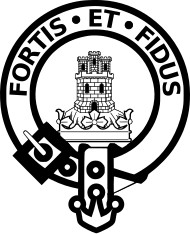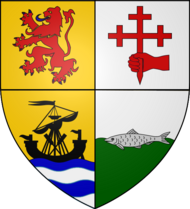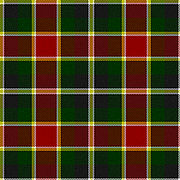
Clan Campbell is a Highland Scottish clan, historically one of the largest and most powerful of the Highland clans. The Clan Campbell lands are in Argyll and within their lands lies Ben Cruachan. The chief of the clan became Earl of Argyll and later Duke of Argyll.

Clan Robertson, is correctly known as Clan Donnachaidh is a Scottish clan. The principal surnames of the clan are Robertson, Reid and Duncan but there are also many other septs.

Cowal is a rugged peninsula in Argyll and Bute, on the west coast of Scotland. It is bounded on the west by Loch Fyne and on the east by Loch Long and the Firth of Clyde. The Kyles of Bute separate it from Bute to the south.
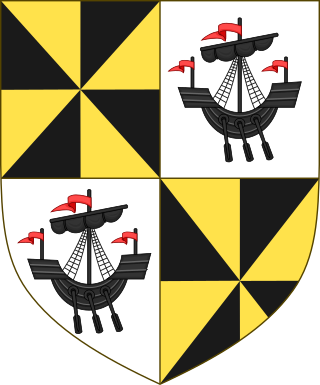
Gillespie Archibald Campbell, 2nd Earl of Argyll was a Scottish nobleman and politician who was killed at the Battle of Flodden.

Clan MacNeil, also known in Scotland as Clan Niall, is a highland Scottish clan of Irish origin. According to their early genealogies and some sources they're descended from Eógan mac Néill and Niall of the Nine Hostages. The clan is particularly associated with the Outer Hebridean island of Barra. The early history of Clan MacNeil is obscure, however despite this the clan claims to descend from the legendary Irish King Niall of the Nine Hostages, who is counted as the 1st Clan Chief, the current Clan Chief being the 47th. The clan itself takes its name from a Niall who lived in the 13th or early 14th century, and who belonged to the same dynastic family of Cowal and Knapdale as the ancestors of the Lamonts, MacEwens of Otter, Maclachlans, and the MacSweens. While the clan is centred in Barra in the Outer Hebrides, there is a branch of the clan in Argyll (McNeill/MacNeill) that some historians have speculated was more senior in line, or possibly even unrelated. However, according to Scots law the current chief of Clan MacNeil is the chief of all MacNeil(l)s.

Clan Maclean is a Highlands Scottish clan. They are one of the oldest clans in the Highlands and owned large tracts of land in Argyll as well as the Inner Hebrides. Many early MacLeans became famous for their honour, strength and courage in battle. They were involved in clan skirmishes with the Mackinnons, Camerons, MacDonalds and Campbells, as well as all of the Jacobite risings.

Clan Macnaghten, Scottish Gaelic: MacNeachdain, is a Scottish clan.
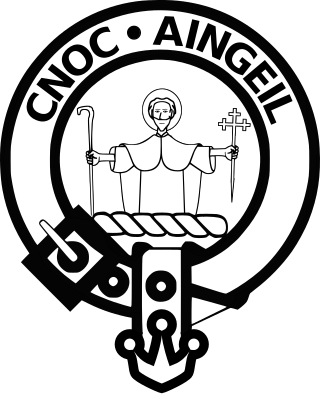
The Clan Livingstone, also known as Clan MacLea, is a Highland Scottish clan, which was traditionally located in the district of Lorn in Argyll, Scotland, and is seated on the Isle of Lismore. There is a tradition of some MacLeas Anglicising their names to Livingstone, thus the Clan Livingstone Society's website also refers to the clan as the Highland Livingstones. The current chief of Clan Livingstone was recognised by Lord Lyon as the "Coarb of Saint Moluag" and the "Hereditable Keeper of the Great Staff of Saint Moluag."

Clan Lamont is a Highland Scottish clan. The clan is said to descend from Ánrothán Ua Néill, an Irish prince of the O'Neill dynasty, and through him Niall Noigíallach, High King of Ireland. Clan Ewen of Otter, Clan MacNeil of Barra, Clan Lachlan, and Clan Sweeney are also descendants of Ánrothán. Traditional genealogy would therefore include Clan Lamont among the descendants of Conn Cétchathach.
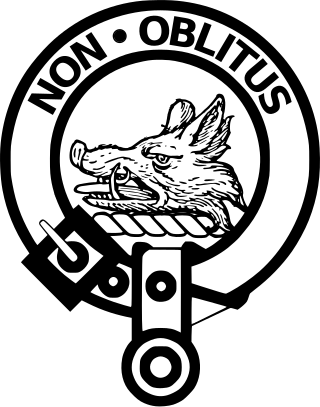
Clan MacTavish is an Ancient Highland Scottish clan.

Clan MacAulay, also spelt Macaulay or Macauley is a Scottish clan. The clan was historically centred on the lands of Ardincaple, which are today consumed by the little village of Rhu and burgh of Helensburgh in Argyll and Bute. The MacAulays of Ardincaple were located mainly in the traditional county of Dunbartonshire, which straddles the "Highland Line" between the Scottish Highlands and Lowlands. Clan MacAulay has been considered a "Highland clan" by writers and has been linked by various historians to the original Earls of Lennox and in later times to Clan Gregor. The MacAulays of Ardincaple, like Clan Gregor and several other clans, have traditionally been considered one of the seven clans which make up Siol Alpin. This group of clans were said to have claimed descent from Cináed mac Ailpín, King of the Picts, from whom later kings of Scotland traced their descent. The chiefs of Clan MacAulay were styled Laird of Ardincaple.

Clan Galbraith is a Scottish clan. The clan does not have a chief recognised by the Lord Lyon King of Arms. Because of this, the clan is considered an armigerous clan, and as such Clan Galbraith has no standing under Scots Law. The clan-name of Galbraith is of Gaelic origin, however its meaning denotes the bearer as of Brythonic origin, as opposed to Gaelic. The early Galbraiths were centred in the Lennox district, which spans the Highland and Lowland border of Scotland. The 17th chief of the clan brought ruin to the clan in the late 16th and early 17th century, and eventually lost his lands and fled Scotland for Ireland. His grandson, the 19th chief, was the last chief of Clan Galbraith.
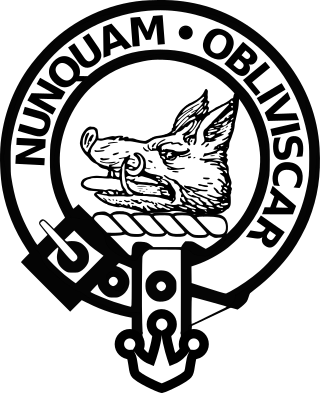
Clan MacIver or Clan MacIvor, also known as Clan Iver, is a Scottish clan recognised by the Lord Lyon King of Arms. The clan, however, does not have a chief recognised by the Lord Lyon King of Arms. Because of this the clan can be considered an armigerous clan. The clan name of MacIver is of Gaelic origin, derived from an Old Norse personal name. Various forms of the surname MacIver, like MacGiver, are considered sept names of several historically large Scottish clans, such as clans Campbell and Mackenzie. There exists a Clan Iver society in Fife, Scotland.

Clan MacEwen or Clan MacEwan is a Scottish clan recorded in the fifteenth century as Clan Ewen of Otter.

A clan badge, sometimes called a plant badge, is a badge or emblem, usually a sprig of a specific plant, that is used to identify a member of a particular Scottish clan. They are usually worn affixed to the bonnet behind the Scottish crest badge, or pinned at the shoulder of a lady's tartan sash. According to popular lore clan badges were used by Scottish clans as a means of identification in battle. An authentic example of plants being used in this way were the sprigs of oats used by troops under the command of Montrose during the sack of Aberdeen. Similar items are known to have been used by military forces in Scotland, like paper, or the "White Cockade" of the Jacobites.

Clan McCorquodale is a Scottish clan, recognised by the Lord Lyon King of Arms, though without a chief so recognised. The last chief of the clan died in the 18th century. Because the clan does not have a recognised chief, it is considered an armigerous clan, and has no legal standing under Scots Law. Historically, the clan inhabited lands west of Loch Awe, in Argyll. These clan lands were centred at Loch Tromlee, where an island castle served as the clan seat. The line of Clan McCorquodale chiefs, first recorded in the 15th century, has been untraced since the 18th century.

Carter-Campbell of Possil is a branch of Clan Campbell, a Scottish clan. Historically, they are part of Clan Campbell, which was regarded as one of the largest Scottish clans. The branch of the Campbell clan was historically centred in Lawers. Some of the clan, which originated with the original Campbells, had links to the lands of Argyll.

Suibhne mac Duinnshléibhe was a late 12th-century, and early 13th-century, lord in Argyll. He does not appear in contemporary records, although his name appears in the patronymic names of two of his sons. Suibhne appears in the 16th century Leabhar Chlainne Suibhne, which documents the early history of Clann Suibhne. This account claims that he is the ancestor of Irish clan, and that he was the builder of Castle Sween in Knapdale, Argyll. However, other sources suggest the castle was built in the late 11th century by Suibhne MacAnrahan, brother of the High King of Ireland. Suibhne is said to be identical to the "Swineruo", or Suibhne Ruadh, recorded in the Ane Accompt of the Genealogie of the Campbells, a 17th-century Clan Campbell genealogy.

Old Castle Lachlan, also known as Castle Lachlan, is a ruined 15th-century castle on the shore of Loch Fyne, within the Cowal Peninsula, in Argyll and Bute, Scotland. It was probably built by Clan Maclachlan on lands first recorded in 1314 as "Castlelachlan". Nothing remains of this fourteenth-century castle. Instead, the enclosure of Old Castle Lachlan appears to date to the early fifteenth century, whilst the internal buildings seem to date to the later part of the century. The castle remained a residence of the clan's chiefs until New Castle Lachlan was built as a replacement in 1790, 0.8 kilometres (0.5 mi) east-north-east.
Clan Ewen of Otter, was a Scottish clan which once controlled the area around Kilfinan on the Cowal peninsula in Argyll.
